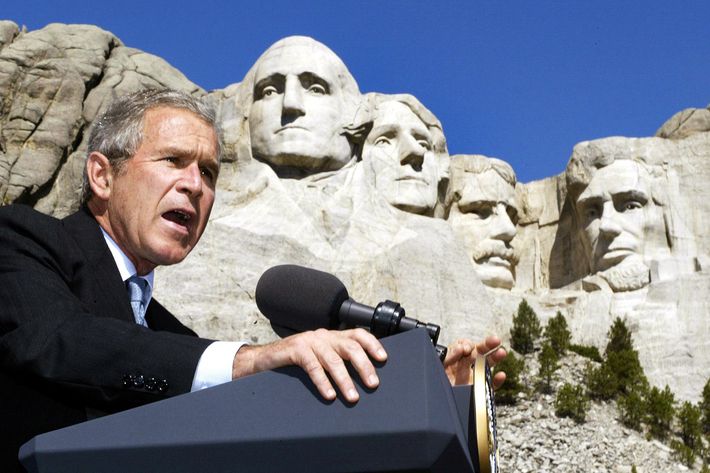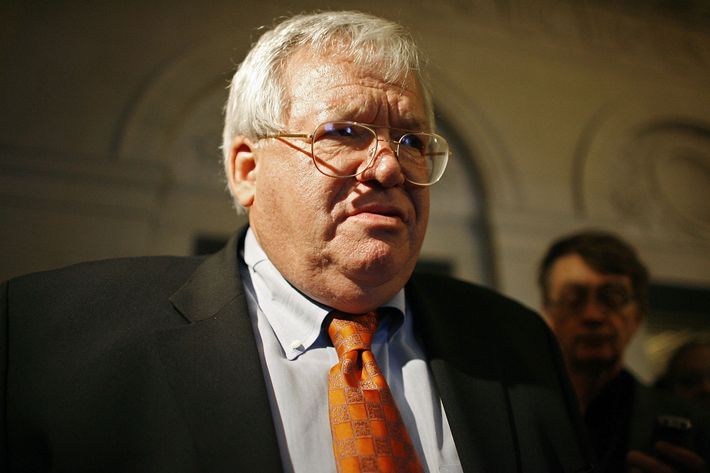
About a decade ago, it became clear to some of us that the Republican and Democratic parties were not at all alike. The two were different, not just in their beliefs but in their methods and political style. The Republican Party was ethnically, economically, and ideologically homogenous. Democrats claimed support from racial minorities along with whites, and unions, consumer advocates, and environmentalists along with business, and moderates as well as liberals, yielding a careful balance of ideas and interests. As a virtually all-white party, whose economic support came exclusively from business and which identified conservatism as its sole legitimate ideological tradition, the Republican Party operated in a very different style. Trump’s capture of the Republican nomination is the most emphatic, but only the most recent, indication that the Republican Party’s internal culture is a total failure.
Not long ago, a deeply ingrained conventional wisdom still saw the two parties as mirror images, one liberal and the other conservative, but otherwise structurally similar. The contrary notion that the two parties had grown asymmetrical, with the Republican Party increasingly extreme and unable to share power, was the premise of my book, a 2006 book by Thomas Mann and Norman Ornstein (which they followed up in 2012), a 2006 book by Jacob Hacker and Paul Pierson, as well as research by political scientists like Keith Poole and Howard Rosenthal and, more recently, David Hopkins and Matt Grossmann.
The very different structure of the two parties produced very different internal cultures. The GOP had essentially become the political arm of the conservative movement, while the Democrats remained more of a polyglot, 20th-century-style party tugged between competing factions and philosophies. Republicans were disciplined and ideological, fervently devoted to a cult of Reagan, which reduced any dispute over party doctrine into a contest of atavistic purity. Democrats tended to be more factionalized, pragmatic, open to compromise, and deferential to the conclusions of experts. The difference spilled over from elected officials and political professionals into intellectuals and pundits — producing what some people called a “hack gap” between the two sides, in which far more liberal opinion journalists showed a greater willingness than conservative journalists to contradict the party line.

Since then, the Democratic Party has slowly begun mimicking some of the characteristics of the GOP. During the Bush administration, despondent liberals consciously studied the success of the conservative movement and set out to replicate its tactics. They have not turned their party into a duplicate of the GOP, but their work has yielded results. In 2005, rather than capitulate to the Bush administration’s pressure campaign to privatize Social Security, Democrats banded to together to block it. They hung together to pass health-care reform in 2010, reflecting a general increase in party discipline. There is now a progressive movement — and while it does not hold the monopoly on left-of-center discourse that the conservative movement wields on the right, it has noticeably changed the tone of liberal discourse. The old incentive for liberal pundits to break from the liberal line (reinforced by an economic structure in which rewards came in the form of jobs at prestige media outlets that cherished nonpartisanship) has been replaced by a new incentive to toe the party line (reinforced by transparent online readership metrics, which incentivize supporting readers’ preexisting values). The hack gap still exists, but it has narrowed.
The upside of the new liberal world is that the old spirit of reflexive contrarianism for contrarianism’s sake has disappeared, as has the habit of moderate Democrats to position themselves automatically to the right of their party merely to signal independence. The downside is the appearance of at least signs of creeping dogmatism. Mainstream liberal economists are deeply concerned that the $15 minimum wage is too high and will harm low-income workers more than it helps, but Democrats have suppressed their doubts in ways that would have been unimaginable a decade ago. The progressive movement is inching toward the rigidly circumscribed rules of discourse surrounding identity developed by the p.c. left (and on display in many campuses).
The question for liberals now is whether the ethos of no-enemies-on-the-left has gone far enough. Left-wing writers like Freddie deBoer and Emmett Rensin gaze upon the culture of the Republican Party, with its relentless privileging of extremism, not with disgust but with envy. Why can’t the Democrats have that, too?
Of course, if one’s goal is to build socialism, rather than mixed-economy liberalism, then obviously you would prefer to tilt the terms of discourse in radicals’ favor. But the suggestion here isn’t just that replicating the GOP’s internal culture is a sensible tactic for the far left, but for the center-left as well. The more extreme the poles of the debate, the more effectively they tug the center of discourse their way. By this reasoning, the moderation of the Democratic Party, and the liberal resistance to the far left, has only allowed the far right to prevail.
This analysis had some appeal ten years ago or so, when it was hard to conclude whether the Republican Party’s greater ideological fervor amounted to an advantage or a handicap. But the Republican Party of 2016 is an odd subject for envy. Trump’s nomination is simply the latest example of the Republican Party’s inability to moderate its impulses or assimilate internal criticism.

Even by the 1990s, the party’s fanaticism was driving it into cycles of overreach, failure, and then attributing every failure to a lack of ideological zeal. During the Clinton administration, right-wing activists pushed the party leadership into a series of disastrous confrontations — a shutdown, impeachment — and then cast their leaders aside as squishes. The Bush administration’s contempt for empiricism seeded the collapse of its foreign and domestic policies, ultimately costing the party all of its power. On the other hand, the right had redefined the terms of public debate by sheer force of will. Once-marginal ideas, like supply-side economics, privatizing Social Security, or neoconservative foreign policy, now dominated the political discourse. Every tactical defeat for the right still seemed to yield a larger strategic victory, short-term sacrifices for the cause of a country whose politics seemed to continue marching ever rightward.
Considered from the perspective of 2016, however, the picture looks very different. The right’s inability to compromise led to a series of permanent, tangible policy defeats. In 2009, and especially after Scott Brown’s election in 2010 deprived them of their filibuster-proof majority, Democrats in Congress were desperate to compromise on health-care reform, willing to accept meager incremental measures if they could gain bipartisan cover. Republicans held out for total victory, leading Democrats to pass a comprehensive reform. In 2011, President Obama (in another moment of political vulnerability) offered them concessions they would have had no chance of passing on their own — real cuts to retirement programs — in return for tax reform that increased revenue. They refused that deal, too. After the 2012 election — when their nominee had to run hamstrung by an unpopular orthodox right-wing platform — Republicans in Congress spurned the advice of a postelection autopsy by refusing to pass immigration reform, leaving them deeply unpopular with growing immigrant communities. Conservatives’ manic insistence that every failure was attributable to their fainthearted leaders selling them out was an effective way to instill fanatic party discipline, but ultimately it destroyed the party.
Trump’s nomination does fly in the face of conservative dogma on some issues. But Trump also reflects the triumph of the curdled rage of the modern Republican Party. All of the constituencies of the old Republican Party that may have stopped Trump in the primaries — racial minorities, socially moderate women, college-educated whites — have been driven out by a party that has lurched right. Tax cuts for the rich, deregulating Wall Street, and cuts to retirement programs have no natural constituency, so Republicans have been left with the only voters who would be willing to support them: culturally conservative whites. Republicans aghast at Trump’s wild abuse of the truth had no authority to which they could turn, having long ago instructed their supporters to ignore the mainstream media.
Trump’s victory was an object lesson in the stifling failure of intra-Republican discourse. There are, of course, some intellectuals on the right who try to moderate their party’s excesses. But the moral logic of movement thought places them at a hopeless disadvantage. The moderates behave like uninvited guests, politely beseeching their hosts to reconsider their views, wrapping any criticisms in elaborate expressions of sympathy, or retreating to morbid irony. The radicals shout, the moderates whisper. The rules of conservative discourse dictated that the only valid attacks against Trump could come from the right, but the party had moved so far right that his heresies — previous support for universal health care, endorsement of higher taxes on the rich, a general lack of enthusiasm for libertarian anti-government abstractions — pulled no weight with their voters. Trump’s nomination was the meltdown of the Republican elite within their own ideological hothouse.






























